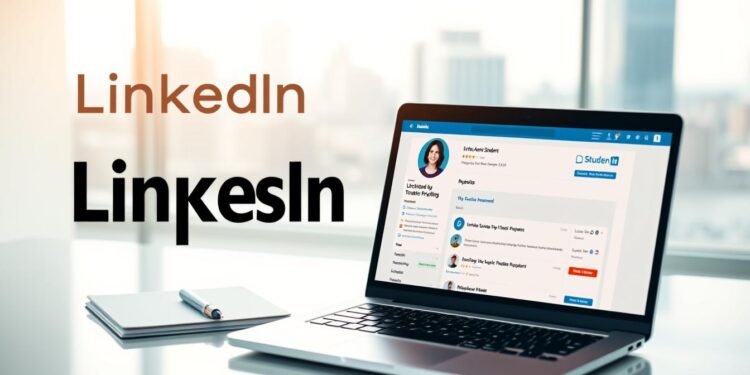Did you know that over 750 million professionals across 200 countries use the same platform to connect, grow, and find opportunities? For college students, this platform isn’t just a social network—it’s a gateway to internships, jobs, and career growth.
Originally a job board, it has evolved into a comprehensive career development ecosystem. Whether you’re looking to build your linkedin profile or explore global opportunities, this platform offers tools to help you stand out.
Optimizing your profile is the foundation for recruiter visibility. From networking to leveraging job search features, this article will guide you through essential strategies to go from zero to recruiter-ready.
Key Takeaways
- LinkedIn is the world’s largest professional network with over 750 million users.
- It has evolved from a job board to a full career development platform.
- College students can use free and premium tools to find internships and jobs.
- Profile optimization is key to increasing recruiter visibility.
- Strategies include networking, job search features, and content engagement.
Why LinkedIn is Essential for College Students
With over 90% of recruiters actively using it, this platform is a must-have for career growth. It bridges the gap between academia and industry, offering tools and resources tailored for students. Whether you’re seeking internships or full-time roles, it’s a powerful way to connect with professionals and explore opportunities.
The Role of LinkedIn in Career Development
This platform serves as a bridge between education and professional success. It allows students to showcase their skills, connect with alumni, and access over 20 million job listings. The algorithmic advantages make it easier for internship seekers to stand out compared to traditional job boards.
Success stories abound, with many students landing roles through alumni connections. Optimized profiles have been shown to increase interview rates by 3X. Additionally, hidden features like company research tools and interview prep resources give students an edge.
How LinkedIn Can Help You Land Internships and Jobs
Recruiters rely heavily on this platform to find talent. For students, it’s a direct line to internships and job openings. The ability to research companies and connect with hiring managers makes it an invaluable tool.
By leveraging alumni networks and engaging with industry professionals, students can uncover opportunities that might not be advertised elsewhere. The platform’s job search features, including Easy Apply, streamline the application process, saving time and effort.
Creating a Professional LinkedIn Profile

Your profile is often the first impression you make on recruiters. A polished and professional presence can significantly boost your chances of landing internships or jobs. Let’s break down the key elements to make your profile stand out.
Choosing the Right Profile Picture
A professional headshot is essential. Profiles with high-quality photos receive 21X more views. Your image should be clear, well-lit, and focused on your face. Avoid selfies or casual photos.
For the best results, use a photo with dimensions of at least 400×400 pixels. Dress appropriately for your industry, and ensure the background is simple and uncluttered. A professional headshot reflects your seriousness and attention to detail.
Writing a Compelling Headline
Your headline is one of the first things recruiters see. Avoid vague phrases like “Seeking opportunities.” Instead, use a formula like “Skill | Aspiring Role | University.” For example, “Marketing Enthusiast | Aspiring Digital Marketer | University of California.”
This approach highlights your skills, goals, and educational background. It gives recruiters a quick snapshot of who you are and what you’re aiming for.
Crafting a Strong Summary
Your summary is your chance to tell your story. The first three sentences get 87% of the attention, so start strong. Begin with a value proposition that highlights your unique strengths.
In the second paragraph, outline your credentials, such as academic achievements or relevant projects. End with a call-to-action, like inviting connections to reach out for collaborations or opportunities.
Here’s an example of a weak vs. strong summary:
Weak: “I’m a student looking for internships.”
Strong: “As a driven marketing student at UCLA, I specialize in social media strategy and content creation. My recent campaign increased engagement by 30%. Let’s connect to discuss how I can contribute to your team.”
Optimizing Your LinkedIn Profile for Search
To stand out in a competitive job market, your online presence must be optimized for search. Recruiters often use filters and algorithms to find candidates. By strategically incorporating keywords and showcasing your skills, you can significantly improve your visibility.
Using Relevant Keywords in Your Profile
Start by identifying keywords that align with your desired role. Use tools like “Skills Trending in Your Network” to find popular terms. Integrate these naturally into your headline, summary, and experience descriptions. For example, instead of “Managed accounts,” write “Increased social engagement by 40% through strategic account management.”
Highlighting Your Skills and Endorsements
Profiles with 5+ skills receive 27X more messages. Focus on adding relevant abilities that match your field. Seek endorsements from verified professionals to enhance credibility. Quality matters more than quantity, so prioritize endorsements from those who know your work well.
Adding Detailed Work and Education History
Recruiters often filter candidates by education. Include your GPA if it’s 3.5 or higher, relevant coursework, and capstone projects. For work experience, quantify achievements to show impact. For instance, “Led a team of 5 to complete a project 2 weeks ahead of schedule” is more compelling than “Managed a team.”
Building Your LinkedIn Network

Building a strong professional network can open doors to countless opportunities. Whether you’re connecting with classmates, professors, or alumni, these relationships can provide mentorship, referrals, and valuable insights into your chosen industry.
Connecting with Classmates, Professors, and Alumni
Start by reaching out to people you already know. Classmates and professors are great connections to begin with. Alumni, in particular, have an 85% acceptance rate for connection requests. Use a personalized message like, “Hi [Name], I noticed your work in [field] and would love to connect.”
Engaging with Industry Professionals
Expand your network by connecting with professionals in your desired field. Follow the 50-30-20 rule: 50% peers, 30% professionals, and 20% recruiters. Engage with their content by commenting thoughtfully or sharing articles. This helps you stay visible and build meaningful relationships.
Joining Relevant Groups
Participating in groups related to your industry can increase your profile views by 4X. Look for student-friendly groups like LinkedIn Campus Editors or NACA Internships. Be active by commenting 3 times a week and sharing one article weekly. Avoid spamming invitations—limit yourself to 50 invites per week to stay within platform guidelines.
Leveraging LinkedIn for Job Search
Finding the right job or internships can feel overwhelming, but with the right tools, it becomes much easier. This platform offers features designed to simplify the process and increase your chances of success. From advanced filters to direct applications, let’s explore how you can make the most of your search.
Exploring Job Postings and Internships
Start by using advanced filters to narrow down your search. Look for entry-level roles, remote opportunities, or positions at startups. These filters help you focus on roles that match your skills and career goals. Tailor your resume and include portfolio links to stand out.
Using LinkedIn’s Easy Apply Feature
The Easy Apply feature is a game-changer. Candidates using this feature receive responses three days faster on average. Create a checklist to ensure your application is complete: tailored resume, portfolio links, and a polished profile. This saves time and increases your chances of getting noticed.
Researching Companies and Recruiters
Before applying, research companies to understand their culture and growth patterns. Look at employee tenure and promotion trends. This helps you identify companies that align with your career aspirations.
When reaching out to recruiters, timing matters. The best time to contact them is Tuesday between 10 AM and 11 AM EST. Additionally, set your profile to “Open to Work” privately, so only recruiters can see it. This increases your visibility without broadcasting your status publicly.
By following these strategies, you can improve your results and land the job or internships you’ve been aiming for.
Conclusion
Your next big opportunity could be just a few optimizations away. Start by dedicating 30 minutes weekly to update your profile. Students who do this receive 3X more inbound messages from recruiters.
Create a 90-day action plan: aim for 10 new connections weekly and share 2 posts monthly. Staying active ensures you remain visible and engaged with your network. Avoid stagnation—47% of student profiles go inactive after creation.
Remember, your next internship or job is closer than you think. Download our profile review checklist to ensure your profile is recruiter-ready. Take action today and unlock your potential!
FAQ
Why is LinkedIn important for college students?
LinkedIn plays a key role in career development by helping students connect with professionals, explore job opportunities, and showcase their skills to potential employers.
How can I create a professional LinkedIn profile?
Start with a clear headshot, write a compelling headline, and craft a strong summary that highlights your goals, achievements, and qualifications.
What are the best ways to optimize my profile for search?
Use relevant keywords in your headline, summary, and skills section. Highlight your achievements, add detailed work and education history, and seek endorsements for your skills.
How do I build a strong LinkedIn network?
Connect with classmates, professors, and alumni. Engage with industry professionals by commenting on posts and joining groups related to your field.
Can LinkedIn help me find internships and jobs?
Yes, you can explore job postings, use the Easy Apply feature, and research companies and recruiters to find opportunities that match your career goals.
What should I include in my LinkedIn summary?
Focus on your career objectives, key skills, academic achievements, and any relevant projects or volunteer work. Keep it concise and professional.
How do I make my profile stand out to recruiters?
Use a professional headshot, include quantifiable achievements in your work descriptions, and regularly update your profile with new skills and experiences.
Are LinkedIn groups useful for students?
Absolutely. Joining groups related to your industry can help you stay updated on trends, connect with professionals, and discover job opportunities.





